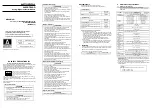
8
05.01
8.7 Circuit examples =1 to =9 with SIMODRIVE 611
8-293
©
Siemens AG 2012 All Rights Reserved
SIMODRIVE 611 Configuration Manual (PJU) – 02/2012 Edition
Armature short–circuit
The pulse enable is withdrawn via terminal 663 when the limit position limit
switch is actuated/passed or when the power fails. The armature short–circuit
contactor –K11 is simultaneously de–energized (opened). The drive is braked
after the contactor drop–out time. The interlocking circuit, terminal 91–92, is
simultaneously opened therefore initiating an EMERGENCY STOP function for
all of the drives. A varistor is connected to the contactor coil in order to achieve
a short contactor dropout time. The selected auxiliary contactor from the SIRIUS
series of industrial controls with mounted, four–pole auxiliary contact element
fulfills ”protective separation” between the control voltage and the 690 V AC
motor circuit. For operation with power failure and when the +24 V control volt-
age is buffered, or for other shutdown functions, the circuit must be appropri-
ately adapted to the particular application.
Holding brake
The fast application of the holding brake, independent of the PLC cycle time
using the armature short–circuit contactor, supports braking. When compared to
armature short–circuit braking, there is a delay before the holding brake actually
closes and starts to brake.
In the setting–up mode, the axis can be moved away using the key–operated
switch –S13 – move away from end position – and pushbutton =5–S11 – agree-
ment.
Circuit example =9 ”Power contactors in the motor circuit”
For special applications, the circuits allow the motor to be galvanically isolated
from the drive module via contactors. The contactors may only be de–energized
with a leading pulse inhibit >=10 ms via terminal 663 with respect to the power
contacts. When powering–up, the pulses must be simultaneously enabled when
the power contacts are closed.
Notice
The contactors are generally not suitable for interrupting clocked inverter
currents or interrupting DC currents of a stationary drive that is in closed–loop
position control. If this is not carefully observed, this can result in high voltage
peaks/spikes when powering–down and in turn can destroy the drive module,
the motor winding and/or cause the contactor contacts to weld.
The drives are powered–down in a safety–relevant way using key–operated
switch –S11 through one channel or –S15 through two channels – a) using the
start inhibit function and b) also using a contactor to galvanically isolate it from
the drive module.
The pulse enable is withdrawn before the power contacts of the power contactor
open as a result of the drop–out delay. The interlocking circuit, terminals
103–104 or terminals 107–108, should be inserted in the start circuit of the
safety combination =4–K31/Y33–Y34, drives stop.
Functions
Application
Functions
8 Important Circuit Information
















































